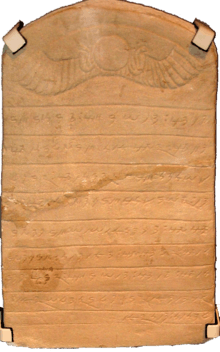Meroitic language
| Meroitic | |
|---|---|
| Native to | Kingdom of Kush (Sudan) |
| Region | Meroë |
| Era | attested 300 BCE – 400 CE |
| Meroitic alphabet | |
| Language codes | |
| ISO 639-3 |
xmr |
Linguist list |
xmr |
| Glottolog |
mero1237[1] |
The Meroitic language (/mɛroʊˈɪtɪk/) was spoken in Meroë and the Sudan during the Meroitic period (attested from 300 BCE) and became extinct about 400 CE. It was written in two forms of the Meroitic alphabet: Meroitic Cursive, which was written with a stylus and was used for general record-keeping; and Meroitic Hieroglyphic, which was carved in stone or used for royal or religious documents. It is poorly understood owing to the scarcity of bilingual texts.

The classification of Meroitic is uncertain due to the scarcity of data and difficulty in interpreting it. Since the alphabet was deciphered in 1909, it has been proposed that Meroitic is related to the Nubian languages and similar languages of the Nilo-Saharan phylum. Claude Rilly is the most recent proponent of the Nilo-Saharan idea: he proposes that it is Eastern Sudanic, the Nilo-Saharan family that includes Nubian (Rilly 2004, 2007, 2012). Rowan (2006, 2011), on the other hand, notes that the Meroitic sound inventory and phonotactics (the only aspects of the language which are secure) are similar to those of the Afroasiatic languages, and dissimilar from Nilo-Saharan languages. For example, very rarely does one find the sequence CVC, where the consonants (C) are both labials or both velars. This is similar to consonant restrictions found throughout the Afroasiatic language family, suggesting that Meroitic might have been an Afroasiatic language like Egyptian. The issue is unresolved and most classifications list Meroitic either as questionably Nilo-Saharan or as unclassified (as Joseph Greenberg did).[2]
References
- ↑ Hammarström, Harald; Forkel, Robert; Haspelmath, Martin; Bank, Sebastian, eds. (2016). "Meroitic". Glottolog 2.7. Jena: Max Planck Institute for the Science of Human History.
- ↑ "What seems clear is that there is no simple linguistic solution waiting in the wings....Greenberg, writing in 1955, was pessimistic about Meroitic: 'the language does not appear to be related to any existing language of Africa.'" Andrew Robinson. 2002. Lost Languages (McGraw-Hill). Page 154.
Bibliography
- Meroitic Newsletter (Paris, Académie des Inscriptions et Belles-Lettres, 1968).
- Böhm, Gerhard : "Die Sprache der Aithiopen im Lande Kusch" in Beiträge zur Afrikanistik, 34 (Wien, 1988). ISBN 3-85043-047-2.
- Rilly, Claude and Alex de Voogt (2012). The Meroitic Language and Writing System, Cambridge University Press, 2012. ISBN 1-10700-866-2.
- Rilly, Claude (March 2004) "The Linguistic Position of Meroitic", Sudan Electronic Journal of Archaeology and Anthropology.
- ———— (2007) La langue du Royaume de Meroe. Paris, Champion.
- Rowan, Kirsty (2011). "Meroitic Consonant and Vowel Patterning". Lingua Aegytia, 19.
- ———— "Meroitic - An Afroasiatic Language?" SOAS Working Papers in Linguistics 14:169–206.
- ———— (2006) Meroitic: A Phonological Investigation. PhD thesis, SOAS (School of Oriental and African Studies).
- Welsby, Derek A. The Kingdom of Kush (London, British Museum Press, 1996), 189-195, ISBN 071410986X.
- Bender, Marvin Lionel, The Meroitic problem, in Bender, M. L., editor, Peoples and cultures of the Ethio-Sudan borderlands, Committee on Northeast African Studies, African Studies Center, Michigan State University, 1981, pp. 5–32.
- Lipiński, Edward (2011). "Meroitic (Review article)1" ROCZNIK ORIENTALISTYCZNY, T. LXIV, Z. 2, 2011 (s. 87–104).
- Francis Breyer: "Einführung in die Meroistik", LIT Verlag, Berlin 2014
